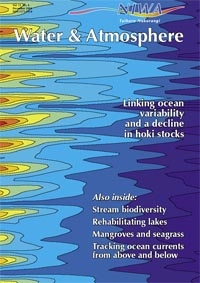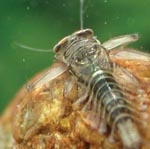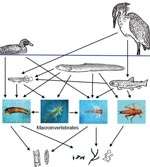PDF of this article (175 KB)

Ngaire Phillips
A better understanding of how freshwater creatures fit into their habitats can point the way to conserving ecosystems.
Next time you look at a mayfly in a fast-flowing stream you might notice that it has a nice flat body shape and that it hugs the pebbles. You might even think that these characteristics (or traits) would be pretty useful in helping it to resist the flow and allow it to “fit” into this rather harsh environment (at least from the mayfly’s viewpoint). This simplistic explanation of why a bug is found where it is provides a good introduction to the topic of species traits. Stream bugs (macroinvertebrates) possess an array of traits which can be used to describe their relationships with the surrounding environment. One application of this relationship is in “biomonitoring” – monitoring the effects of human disturbances on aquatic environments. Biomonitoring involves the use of organisms to assess the health of the environment and is based on our understanding of how organisms interact with their environment.
Species traits

Species possess biological traits that reflect how they are born, how they live (including growth, feeding, movement, dispersion, and reproduction), and how they die (see “Examples of species traits” below). We assume that these traits have evolved as a consequence of selective pressures exerted by the organism’s environment. Certain suites of traits allow species to be successful in a given environment. Species that do not have the required traits do not survive, and disappear from the community. Species traits provide a means of examining the links between biological characteristics and how ecosystems operate. For example, the kinds of food (energy) sources available at a site will reflect the kinds of feeding mechanisms found; an open stream with slimy rocks can support grazing animals, such as snails. In addition, rather than simply recording a loss or reduction in numbers of a species as a result of a disturbance, use of species traits allows us to identify the most sensitive life history characteristic (trait).
Species traits as biomonitors
Historically, biomonitoring has focused on changes in community structure (distribution and abundance). For example, we describe the community structure upstream and downstream of a pollution source, but seldom address changes in ecosystem function or mechanisms for the changes. From the species trait perspective, the community downstream of a pollution source is made up of those species that have the suite of traits tolerant of altered environmental conditions. Species without these traits cannot survive and have been filtered out. By looking at the species traits that are successful downstream of a pollution source, we are better placed to identify the mechanisms behind the effects of pollution. Management of the pollution source can then be better targeted.
Studies have shown that undisturbed macroinvertebrate communities display a diversity of species traits and develop towards more specialised communities (with reduced diversity and functionality) when disturbed by humans. In one study, a comparison was made between “traditional” methods of biomonitoring (such as water quality, diversity and sensitivity indices, community analysis) and methods using species traits. Stream macroinvertebrate communities were measured upstream and downstream of a wastewater treatment plant. Species traits were generally found to be better at differentiating upstream and downstream sites than conventional methods. Another benefit of the species trait approach is that species composition can be variable through space and time, but species trait composition tends to be more stable.
By looking at multiple traits simultaneously, we can better understand how the macroinvertebrate community changes as environmental conditions vary. This approach also increases the probability of detecting impacts, as we are able to use multiple indicators.
Potential applications

Scientists at NIWA are currently examining the responses of macroinvertebrate species traits to pollution. We are collaborating with colleagues from the University of Lyon, France, and the University of Otago. We also see that species traits can be applied to a number of other key areas in stream research. These include:
- providing a measure of functional diversity of New Zealand aquatic communities, adding to existing knowledge of biodiversity;
- understanding the effects of natural disturbances on the functioning of river ecosystems;
- understanding the effects of changing hydraulic habitat conditions associated with flow regulation in rivers;
- assessing the effectiveness of stream restoration projects in re-establishing essential ecological functions;
- providing the framework for functional descriptions/biomonitoring of other biotic communities, such as marine benthos or aquatic plants.
As the methods do not require detailed taxonomic knowledge of the fauna, they are potentially transferable to situations where limited information is available (for example, in developing countries) and for animal groups where taxonomic knowledge is limited (such as microbes).
Species traits offer an exciting approach for examining how streams function. The results of investigations to date suggest that species traits may provide a viable additional approach for biomonitoring, based on the functioning of ecosystems.
Examples of species traits
General life history
- Size – small, medium, large
- Adult longevity – weeks, days, months, or years
Reproduction
- Type – sexual, asexual, hermaphroditic
- Frequency – yearly, more or less than once per year
- Characteristics of egg-laying – on water or land, under water; free floating or cemented to a surface
- Number of descendants – per individual, per year
Dispersion
- Mobility – swims, crawls, burrows, attaches
- Body form – shape (streamlined, rounded, flattened), flexibility (low, moderate, high)
General physiology
- Feeding – filter feeder, grazer, predator, algal piercer
- Respiration – gills, siphons, general body surface, bubbles of oxygen
Macroinvertebrates and stream functioning
Macroinvertebrates play significant roles in how stream ecosystems function.
- They are significant consumers and are therefore intimately involved in the flow of matter and energy.
- They provide critical linkages in energy from microbial to vertebrate populations.
- They are a major component of stream biodiversity.
Further reading
Charvet, S.; Roger, M.C.; Faessel, B., Lafont, M. (1998). Biomonitoring of freshwater ecosystems by the use of biological traits. Annales de Limnologie–International Journal of Limnology 34: 455–464.
Townsend, C. R.; Doledec, S.; Scarsbrook, M. R. (1997). Species traits in relation to temporal and spatial heterogeneity in streams: A test of habitat templet theory. Freshwater Biology 37: 367–387.
Ngaire Phillips is based at NIWA in Hamilton.
Teachers’ resource for NCEA AS: Biology 2.5, 3.1. See other curriculum connections at www.niwa.co.nz/pubs/wa/resources
